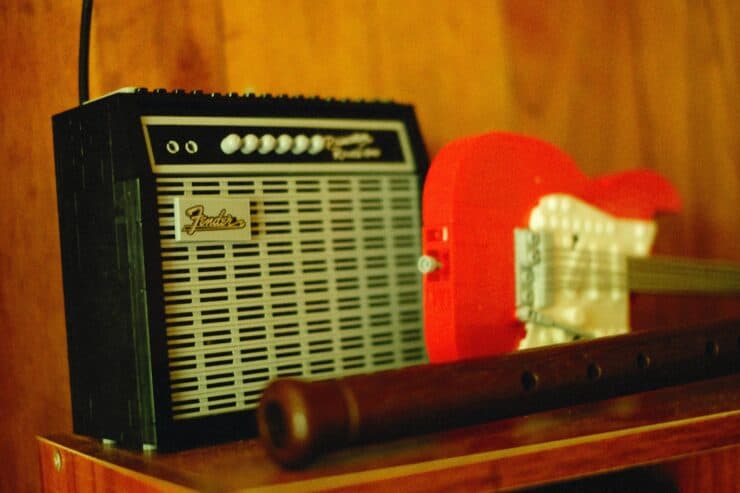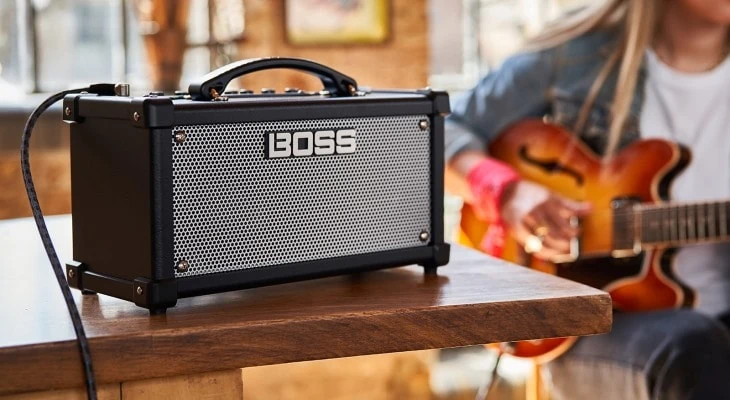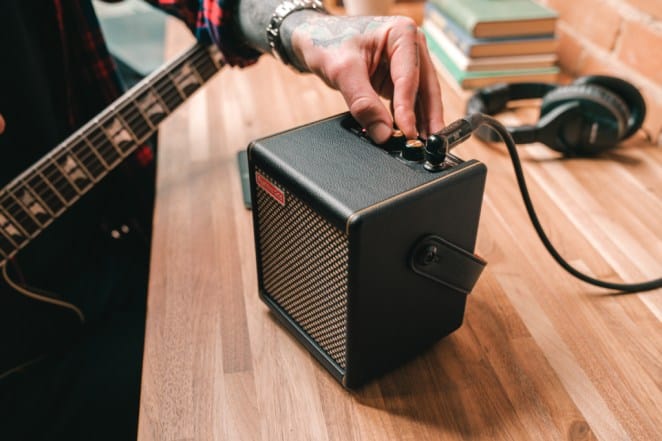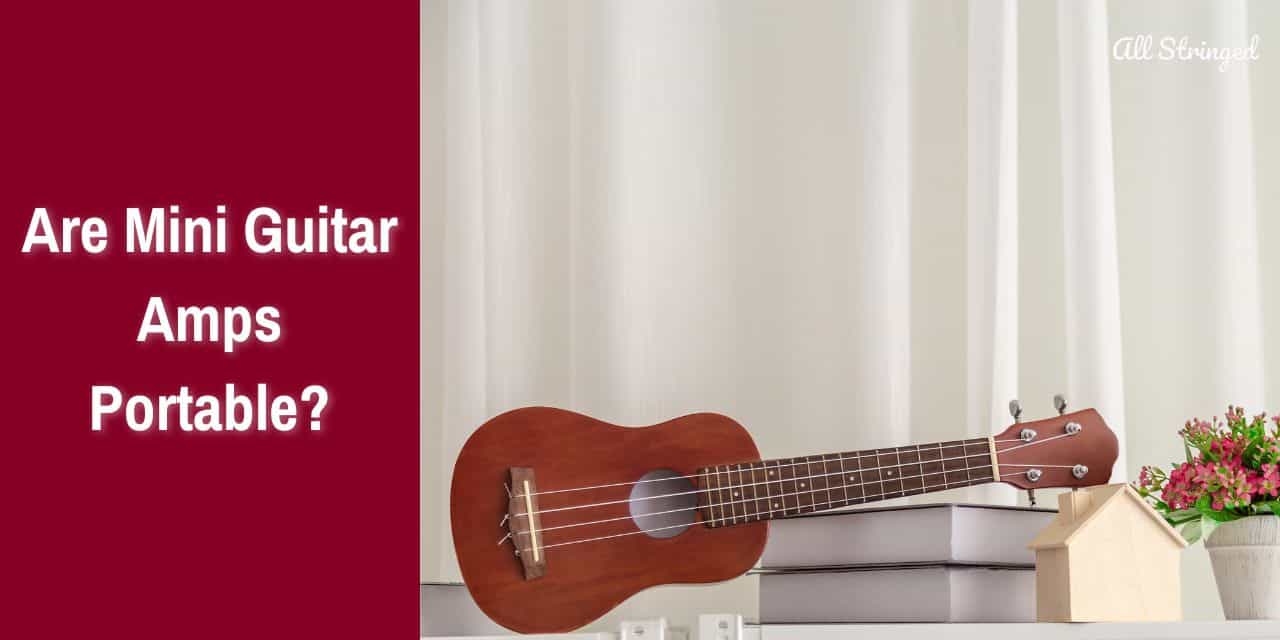Guitar players, have you ever wondered if mini guitar amps have the potential to be portable? Well, you’re in luck! In this article, we’ll be exploring the key features of mini guitar amps and their portability. So, let’s dive right in and find out if mini guitar amps are truly portable. By the end of this article, you’ll know if mini guitar amps can fit into your gig bag or not. Ready to get started? Let’s go!
How do mini guitar amps work?
Mini guitar amps have become increasingly popular among guitarists and musicians due to their compact size, portability, and impressive sound capabilities. These pint-sized powerhouses are designed to deliver a remarkable guitar tone without the bulk and weight of traditional amps.
Mini guitar amps or also known as micro or portable guitar amps are compact amps designed to produce sound from an electric guitar. They are significantly smaller than standard guitar amps, making them easy to carry around and ideal for practice sessions, small gigs, busking, or studio recording.
>>> Click here to read our review about the Top 15 Best Mini Guitar Amps <<<
Despite their small size, mini guitar amps are equipped with essential features found in regular-sized amps, including volume controls, tone shaping, and sometimes built-in effects. They are powered by batteries or external power sources, allowing musicians to play anywhere, whether indoors or outdoors.
Mini guitar amps work similarly to regular guitar amps but with a few key differences to accommodate their size and portability. Like regular guitar amps, mini guitar amps also have a preamp stage, which is responsible for boosting the weak electrical signal from the guitar’s pickups. The preamp controls, usually found on the front panel, allow the musician or guitarist to adjust the volume gain and tone shaping to achieve the desired sound.
The preamp signal is then sent to the power amp stage, where it is amplified further to drive the speaker and produce sound. Despite their small size, mini guitar amps can pack a surprising punch and produce enough volume for personal practice or small-scale performances.
Mini guitar amps come equipped with small speakers that are specially designed to fit within the compact enclosure. These speakers, although smaller than those found in regular amps, are optimized for efficiency and can deliver a clear and punchy sound.
Mini guitar amps can be powered in various ways. Some models operate on batteries, which makes them highly portable and perfect for on-the-go performances. Meanwhile, others come with a power adapter, allowing musicians to connect to a wall outlet for extended playing sessions. These amps also come with built-in effects. These effects add versatility and creativity to the player’s sound without the need for additional pedals or processors.
Are mini guitar amps portable?
As technology advances, musicians and guitarists seek more convenient solutions and the popularity of mini guitar amps continues to rise. In the world of music, portability is often seen as a prized characteristic of any equipment, especially for guitarists who are constantly on the move.
Mini guitar amps have become increasingly popular due to their compact size, lightweight construction, and battery-powered functionality. This might make you wonder are mini guitar amps portable. The answer to this question is yes, mini guitar amps are definitely portable.
In fact, these pint-sized powerhouses offer a level of portability that was once unimaginable in the world of guitar amplification. From seasoned professionals to aspiring beginners, the high portability of mini guitar amps has become a game-changer for musicians worldwide. There are different aspects that influence the portability of mini guitar amps.

Size of mini guitar amps
The first aspect that contributes to the portability of mini guitar amps is their compact size. These amps are designed to be significantly smaller than their larger counterparts without compromising on essential features and sound quality. The reduction in size allows mini guitar amps to be easily transported, making them an ideal choice for musicians and guitarists who are constantly on the move.
The compact size and design of mini guitar amps also means that they can easily fit into gig bags, backpacks, or even be carried by hand. This makes them perfect for musicians who frequently travel for gigs, jam sessions, or recording sessions as they can bring their amp along without the hassle of lugging around bulky equipment.
Lightweight construction
In addition to their small size, mini guitar amps are also constructed with lightweight materials, further enhancing their portability. These amps often incorporate durable yet lightweight plastics and metals to ensure they remain sturdy while being easy on the shoulders.
The deduced weight of mini guitar amps is especially beneficial for musicians and guitarists who need to carry their equipment for extended periods. Whether you are traveling for a gig venue, navigating through a crowded subway, or simply moving around a rehearsal space, the lighter weight of mini guitar amps ensures that you won’t be burdened by the weight of your equipment.
Mini guitar amps being battery-powered
Perhaps one of the most defining aspects that make mini guitar amps truly portable is their battery-powered functionality. Unlike traditional guitar amps that require a direct power source or an external power outlet, mini guitar amps can be operated using batteries.
The battery-powered feature liberates musicians and guitarists from the constraints of finding a power source, allowing them to easily play their music virtually anywhere. Whether you are jamming in a park, practicing in a quiet corner, or playing on the go, mini guitar amps will grant you the freedom to amplify your music without being tied down by cords or power cables.
Versatility in mini guitar amps
The high portability and versatility factor of mini guitar amps opens up the doors to endless possibilities for musicians and guitarists in various scenarios. Whether you have to practice at home, jamming with friends, busking on the streets, or playing small gigs, mini guitar amps are versatile enough to adapt to any situation.
Their high level of convenience extends to recording studios, where musicians can easily take their mini guitar amp along for recording sessions without the need for elaborate setups. In rehearsal spaces or shared living environments, mini guitar amps with headphone jacks allow for silent practice, ensuring undisturbed creativity and focused learning.
Different types of mini guitar amps
Mini guitar amps have revolutionized the world of music, offering compact and portable solutions for guitarists who need to take their sound on the go. Despite their small size, these small and portable amps come in various types, each with distinct features and tonal characteristics. Here are the different types of mini guitar amps in the market, helping you understand which one suits your musical needs the best.
Tube mini guitar amps
Tube amps or also known as valve amps have a rich history in the world of guitar amps. These amps are known for their warm and dynamic tone, favored by many professional guitarists for their organic sound quality and natural compression. Despite their larger counterparts being popular among musicians for decades, tube mini guitar amps offer the same vintage appeal and tonal characteristics in a more portable package.
Tube amps produce a harmonically rich and warm sound that is highly sought after by guitar purists and enthusiasts. As tube amps are driven to higher volumes, they produce natural, smooth overdrive and distortion, which makes them ideal for rock, blues, and classic rock genres. Tube amps have a responsive touch and dynamic range, which means they react to the player’s nuances and playing style.
While tube mini guitar amps are more portable than their larger counterparts, they are still heavier and bulkier compare to solid-state and digital modeling amps. Tube amps require regular maintenance and tube replacements, which can be more time-consuming and costly than other types of amps.
Solid-state mini guitar amps
Solid-state amps use transistors and integrated circuits to amplify the guitar signal. They are known for their reliability, affordability, and lightweight design. Solid-state mini guitar amps are perfect for players seeking a practical and durable option without sacrificing tone.
Solid-state amps have fewer moving parts than tube amps, which makes them more resistant to wear and tear. These amps are usually the lightest among the three types, making them highly portable and easy to carry. They’re generally more budget-friendly compared to tube amps and digital modeling amps, making them accessible to a wide range of musicians.
While solid-state amps offer clean and precise tones, some guitarists might find them lacking the warm and organic sound associated with tube amps. Achieving natural overdrive can be more challenging with solid-state amps, as their clipping is often less dynamic than tube amps.

Digital modeling amps
Digital modeling amps make use of advanced digital signal processing technology to recreate the sounds of various amplifier types, cabinets, and effects. These mini guitar amps offer a wide range of tonal possibilities, making them a popular choice for players who want versatility and convenience in a single package.
Digital modeling amps can replicate the sounds of different amps, from classic tube tones to modern high-gain sounds, offering an extensive range of tonal options. Many digital modeling amps come with built-in effects, such as delay, reverb, modulation, and more, eliminating the need for additional pedals. Despite their versatility, digital modeling amps are often compact and lightweight, making them a practical choice for musicians on the move.
Digital modeling amps have more complex controls and settings, requiring some time to familiarize oneself with all the features and options. Some musicians and guitarists might notice subtle digital artifacts or a less organic feel compared to tube or solid-state amps, particularly at higher gain settings.
Hybrid amps
Hybrid amps are designed to combine the best aspects of the tube and solid-state amps. These guitar amps typically feature a tube preamp section paired with a solid-state power amp section. The tube preamp adds warmth and dynamics to the tone whereas the solid-state power amp provides efficiency and reliability.
Tue combination of tube and solid-state technology in hybrid amps allows for a wide range of tones and sounds. Guitarists can enjoy the warmth and richness of tube-driven tones alongside the practicality and reliability of solid-state components. Hybrid amps can often come with built-in effects, which makes them versatile and suitable for various musical genres and playing styles.
The tube preamp section adds depth and character to the sound, giving the guitar tone a classic, vintage feel. The solid-state side of the hybrid amps offers efficient power delivery while needing less maintenance compared to full tube amps. These amps also offer a wide range of tones and built-in effects, making them suited for various musical genres and playing styles.
Pros and cons of mini guitar amps
Mini guitar amps have gained a lot of popularity among musicians for their portable and convenient design. These compact amps offer a practical solution for guitarists who prioritize mobility and ease of use. However, like any piece of equipment, mini guitar amps come with their own set of advantages and disadvantages.
Here are some of the pros of mini guitar amps –
#1. Convenience over transportation
Arguably the most significant advantage of mini guitar amps is their convenience over transportation or portability. These compact amps are lightweight and quite easy to carry, making them ideal for musicians on the go. Whether you are heading to a friend’s house for a jam session, playing at a small gig, or just practicing in your bedroom, mini guitar amps can easily fit into a backpack, allowing you to play wherever inspiration strikes.
#2. Space-saving design
Mini guitar amps are perfect for musicians who have limited space in their homes or apartments. Their small size means that they can be easily stored on a shelf or desk, eliminating the need for large amp cabinets that can take up valuable floor space.
#3. Versatility
Many mini guitar amps come with built-in effects and multiple channels, offering a surprising range of tones and sounds. Some models also include headphone jacks, allowing for silent practice without disturbing others. These features make mini guitar amps versatile tools for musicians looking to experiment with different sounds and styles.

#4. Affordable option
Compared to larger, high-end guitar amps, mini guitar amps are generally more budget-friendly. They offer a cost-effective solution for beginners or musicians who need a backup amp for smaller gigs or practice sessions.
Here are some of the cons of mini guitar amps –
#1. Limited power and volume
Due to their compact size, mini guitar amps often lack the power and volume of larger amps. While they are suitable for practice sessions and small performances, they might not be sufficient for larger venues or gigs with a full band.
#2. Sound quality
The smaller speakers and components in mini guitar amps can sometimes result in a compromise in sound quality. While many models do a great job of delivering clear and punchy tones, they might not match the richness and depth of larger and more expensive amps.
#3. Lack of headroom
Headroom refers to an amp’s ability to handle increased volume without distortion. Mini guitar amps might have limited headroom, leading to distortion at higher volume levels. This can be a drawback for musicians who require clean tones in louder settings.
#4. Limited features
While some mini guitar amps come equipped with built-in effects, they might not offer the same level of customization and versatility as dedicated pedalboards and larger amps. Musicians who rely heavily on effects might find mini guitar amps to be somewhat limiting in this aspect.
Tips to remember when using mini guitar amps
Mini guitar amps have become an increasingly popular option among musicians and guitarists due to their portability, convenience, and impressive sound. Whether you are a beginner honing your skills or a seasoned guitarist looking for a portable practice solution, knowing the tips to set up your mini guitar amp and practice will enhance your overall playing experience. Here are some of the valuable tips you must keep in mind when using a mini guitar amp.
#1. Choosing the right location
Before you set up your mini guitar amp, you need to choose a suitable location for practice or performance. While mini guitar amps are ideal for playing on the go, it is important to find a quiet and distraction-free area where you can focus on your playing without any disturbance. If you are practicing at home, you should consider setting up a room with good acoustics to enhance the sound quality of your mini guitar amp.
#2. Powering up the mini guitar amp
Most mini guitar amps can be powered in two ways – using batteries or through an external power adapter. For home practice, it is quite convenient to use the power adapter, ensuring a stable power source without worrying about battery life. Meanwhile, batteries are an excellent choice for on-the-go playing, allowing you to practice or perform in any location without being tied to a power outlet.
#3. Adjusting the settings
Mini guitar amps typically come with straightforward controls for volume, tone, and sometimes additional features such as gain or built-in effects. Experiment with these settings to find the perfect sound that suits your playing style and preferences. Start off with a low volume and gradually increase it to prevent sudden loud sounds that might cause disturbances.
#4. Headphone jack and silent practice
Many mini guitar amps come equipped with a headphone jack, allowing you to practice silently without disturbing others. Using headphones also allows you to focus solely on your playing, allowing you to hear every detail of your performance without external distractions.
#5. Explore built-in effects
Many mini guitar amps come with built-in effects such as delay, reverb, chorus, and more. You should take the time to explore these effects to add depth and variety to your playing. However, you should remember that less is often more. Only use effects tastefully and in moderation for enhancing your sound without overpowering it.
#6. Recording capabilities
Some mini guitar amps also come with recording capabilities, allowing you to connect them directly to a computer or recording device. This feature is invaluable for capturing your practice sessions or ideas for future reference and improvement. Brands like Boss, Vox, etc. have an impressive range of mini guitar amps to allow you to practice and record.
#7. Experimenting with different playing styles
Mini guitar amps are highly versatile and can handle different playing styles, from clean tones to heavy distortion. You must take full advantage of this flexibility by experimenting with different playing techniques and musical genres. This exploration will not only enhance your skills but also help you discover the full potential of your mini guitar amp.
FAQs
Are mini guitar amps portable?
Yes, mini guitar amps are generally very portable. Many mini amps are designed to be lightweight and compact, making them ideal for use on the go. Some mini amps even come with built-in batteries, allowing you to practice anywhere without needing to be near an outlet.
What are the benefits of using a mini guitar amp?
Mini guitar amps are great for practice because they are lightweight and portable, yet still provide a good sound and volume level. They are also much more affordable than larger amps, making them a great option for those on a budget. Additionally, many mini amps come with built-in effects, allowing you to experiment with different sounds without needing to purchase separate effects pedals.
Are mini guitar amps suitable for live performances?
Mini guitar amps are not typically suitable for live performances due to their limited power and volume levels. However, if the venue is small or the performance is an acoustic set, then a mini amp may be suitable. It is important to consider the size of the venue and the type of performance you are playing before deciding if a mini guitar amp is suitable.



